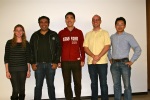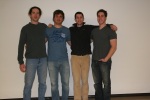This is the End
Class lectures were over last week, but most teams kept up the mad rush to talk to even more customers and further refine their products. Now they were standing in front of us to give their final presentations. They had all worked hard. Teams spent an average of 50 to 100 hours a week on their companies, interviewed 50+ customers and surveyed hundreds (in some cases thousands) more.
While the slide presentations of each team are interesting to look at, that’s actually the sideshow. What really matters are the business model canvas diagrams in the body and appendix of each presentation. These diagrams are the visual representation of the how and the what a team learned in the class – how they tested their hypotheses by getting out of the building using the Customer Development process and what they learned about each part of their business model.
By comparing the changes the teams made week-to-week-week in their business model canvas diagrams, you’ll see the dynamics of entrepreneurship, as they iterate and Pivot over time. We believe these are the first visual representations of learning over time.
Team Agora
To see the Agora slides, click here.
Team Autonomow
To see the Autonomow slides, click here.(p.s. they’re going to make a company out of this class project, and they’re hiring engineers.)
Team Blink Traffic
Team D.C. Veritas
Team Mammoptics
To see the Mammoptics slides, click here.
Team OurCrave
Team PersonalLibraries
Team PowerBlocks
Team Voci.us
To see the Voci.us slides, click here.———
Why Did We Teach This Class?
Many entrepreneurship courses focus on teaching students “how to write a business plan.” Others emphasize how to build a product. We believe the former is simply wrong and the later insufficient.
Business plans are fine for large companies where there is an existing market, existing product and existing customers, but in a startup all of these elements are unknown and the process of discovering them is filled with rapidly changing assumptions. Experienced entrepreneurs realize that no business plan survives first contact with customers. So our goal was to teach something actually useful in the lives of founders.
Building a product is a critical part of a startup, but just implementing build, measure, learn without a framework to understand customers, channel, pricing, etc. is just another engineering process, not building a business. In the real world a startup is about the search for a business model or more accurately, startups are a temporary organization designed to search for a scalable and repeatable business model. Therefore we developed a class to teach students how to think about all the parts of building a business, not just the product.
There was no single class to teach aspiring entrepreneurs all the skills involved in searching for a business model (business model design, customer and agile development, design thinking, etc.) in one quarter. The Lean LaunchPad was designed to fill that void.
What’s Different About the Class?
The Lean LaunchPad class was built around the business model / customer development / agile development solution stack. Students started by mapping their assumptions (their business model) and then each week they tested these hypotheses with customers and partners outside in the field (customer development) and used an iterative and incremental development methodology (agile development) to build the product.
The students were challenged to get users, orders, customers, etc. (and if a web-based product, a minimum feature set) all delivered in 8 weeks. Our goal was to get students out of the building to test each of the nine parts of their business model, understand which of their assumptions were wrong, make adjustments and continue to iterate based on what they learned. They learned first-hand that faulty assumptions were not a crisis, but a learning event called a pivot —an opportunity to change the business model.
What Surprised Us?
- The combination of the Business Model Canvas and the Customer Development process was an extremely efficient template for the students to follow – even more than we expected.
- It drove a hyper-accelerated learning process which led the students to a “information dense” set of conclusions. (Translation: they learned a lot more, in a shorter period of time than in any other entrepreneurship course we’ve ever taught or seen.)
- The process worked for all types of startups – not just web software but from a diverse set of industries – wind turbines, autonomous vehicles and medical devices.
- Insisting that the students keep a weekly blog of their customer development activities gave us insight into their progress in powerful and unexpected ways. (Much more on this in subsequent blog posts.)
What Would We Change?
- In this first offering of the Lean Launchpad class we let students sign up without being part of a team. In hindsight this wasted at least a week of class time. Next year we’ll have the teams form before class starts. We’ll hold a mixer before the semester starts so students can meet each other and form teams. Then we’ll interview teams for admission to the class.
- Make Market Size estimates (TAM, SAM, addressable) part of Week 2 hypotheses
- Show examples of a multi-sided market (a la Google) in Week 3 or 4 lectures.
- Be more explicit about final deliverables; if you’re a physical product you must show us a costed bill of materials and a prototype. If you’re a web product you need to build it and have customers using it.
- Teach the channel lecture (currently week 5) before the demand creation lecture (currently week 4.)
- Have teams draw the diagram of “customer flow” in week 3 and payment flows in week 6.
- Have teams draw the diagram of a finance and operations timeline in week 9.
- Find a way to grade team dynamics – so we can really tell who works well together and who doesn’t.
- Video final presentations and post to the web. (We couldn’t get someone in time this year)
It Takes a Village
While I authored these blog posts, the class was truly a team project. Jon Feiber of Mohr Davidow Ventures and Ann Miura-Ko of Floodgate co-taught the class with me (with Alexander Osterwalder as a guest lecturer.) Thomas Haymore was our great teaching assistant. We were lucky to get a team of 25 mentors (VC’s and entrepreneurs) who selflessly volunteered their time to help coach the teams. Of course, a huge thanks to the 39 Stanford students who suffered through the 1.0 version of the class. And finally special thanks to the Stanford Technology Ventures Program; Tom Byers, Kathy Eisenhardt, Tina Selig for giving us the opportunity to experiment in course design.
E245, the Lean LaunchPad will be offered again next Winter. See you there!









